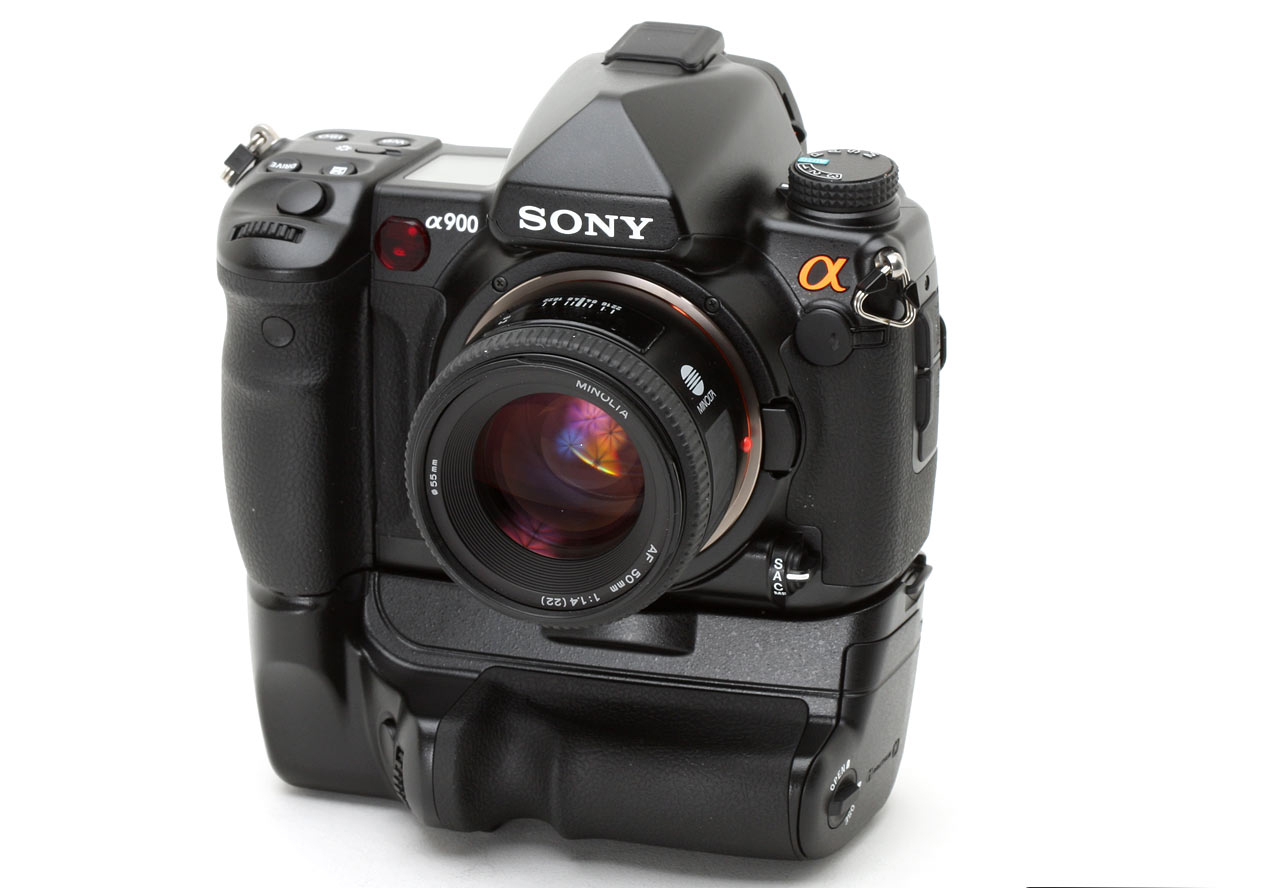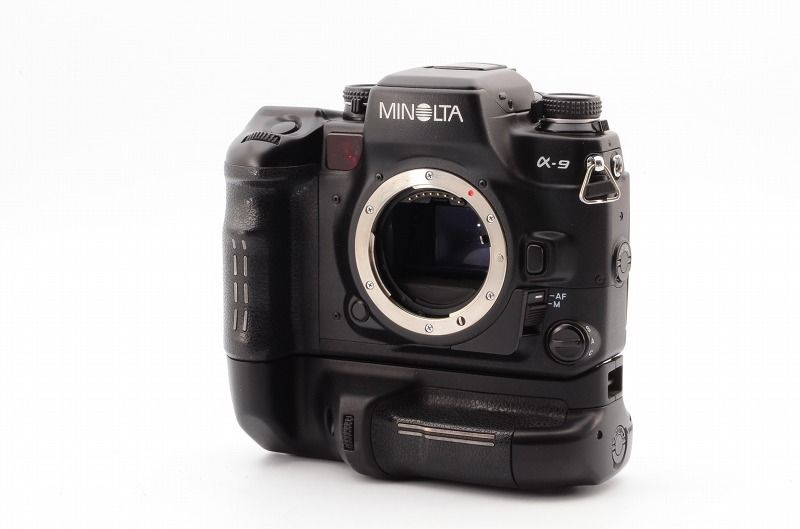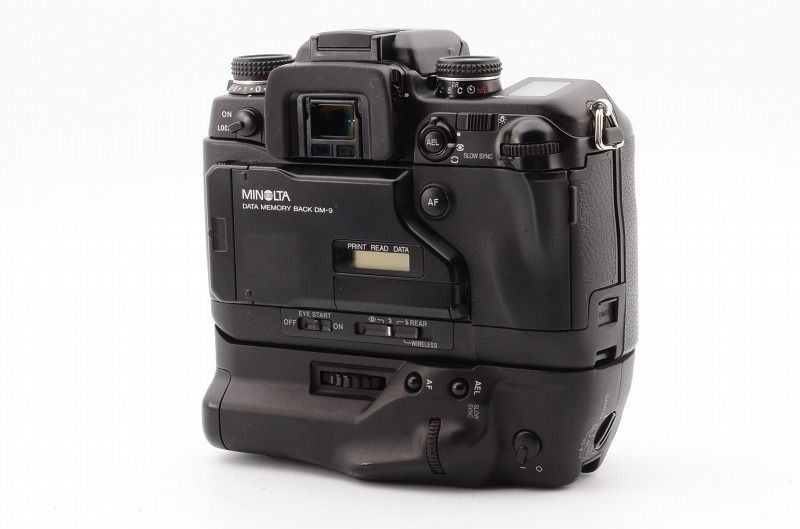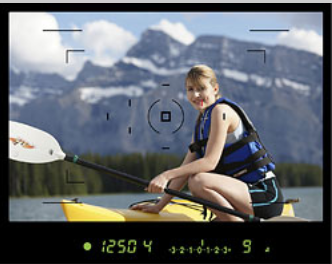Design
Minolta Maxxum 9 is considered by many photographers as one of the finest film cameras ever produced (along with Nikon F5/F6 & Canon 1V) and Sony A900 is perceived as its digital reincarnation. Both cameras look quite similar as you can see from the images below.
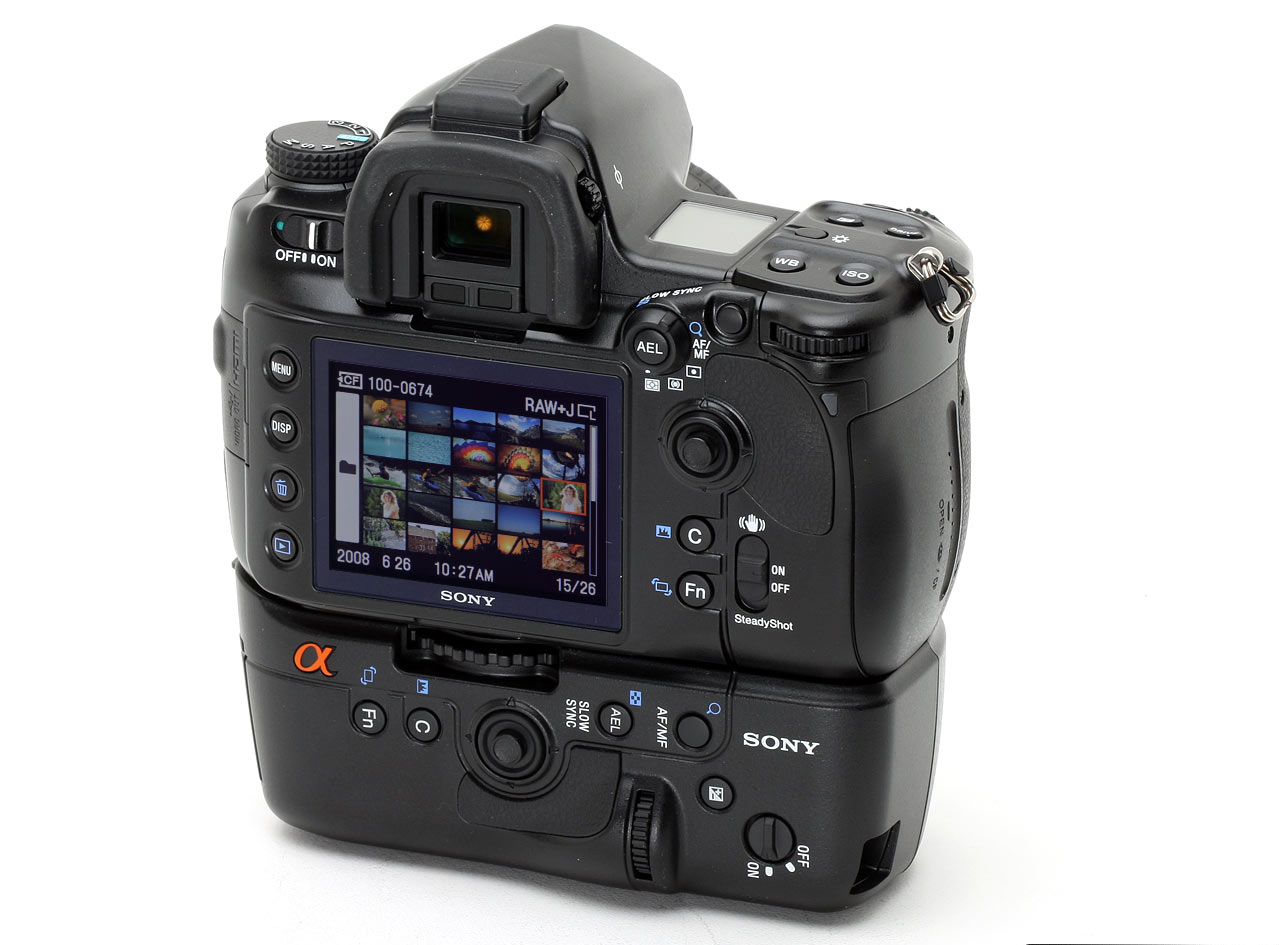
As a stand-alone camera A900 looks quite compact but when the vertical grip is attached it has a similar size to any professional Canon or Nikon body. It reminds of those huge DSLR bricks from the dawn of the digital photography and many may believe it to be a 35 mm SLR at first sight.
With its rather conservative look and lack of modern DSLR features like video mode, live view, Wi-Fi, GPS etc., Sony A900 is quite simple and intuitive to use. There is nothing to get in the way of image taking since all major image controls are available as external buttons and you never need to dig in the camera menu to tweak them when necessary.
Although having a grip attached to the camera is not mandatory not having such is like you have bought half of the camera. This is one of the rare cases where you must possess something expensive you know you do not need but cannot help it.
The vertical grip is quite special and rather expensive. It has large external buttons easy to access if you have bigger hands or have put your gloves on during cold weather.
Both the camera and the battery grip have recesses for your fingertips which allows you to shoot all day long without feeling so much fatigue in your hands as with other camera grips. The battery grip is slightly longer and larger which makes vertical shooting of portraits even easier, especially if you have mounted heavy glass at the front like a 70-200 f2.8 lens.
In any case, despite adding extra weight to an already heavy A900 body the vertical grip makes both horizontal and vertical framing more comfortable and the camera much steadier than using it on its own.
Since Sony had lost its mind when introducing this grip at such a ridiculous price nowadays it is still difficult to find this accessory for less than 250 USD/Euro. So, my advice here is to give a try to a 3rd party vertical grip. You can find many on ebay which look great (Meike MKA900), have all major buttons and cost 1/3 of the original price.
Here are some brief thoughts about A900by Mike Thomas:
Big & bright FF OVF
Well, if you are looking for the biggest reason to buy this camera… look no further!
The viewfinder is the single most valuable characteristic of any SLR camera, being film of digital. If you have used film SLRs in the past you must have heard about the legendary big, bright and clear viewfinders of cameras like Olympus Om 1, Pentax ME, Minolta Maxxum 7& 9, Contax SRT to name a few. Ever since DSLRs came across the quality of viewfinders went down the hill. One of the reasons was that companies focused way too much on smaller than 35mm sensors like the APS-C format. Naturally they collected less light so the image reflected to the eye was dimmer. Part of the light entering the sensor was consumed by the light meter, the focusing screen and for metering of the scene captured. And again, more light was lost in the digital capture then on a film frame so digital viewfinders become visibly inferior to their predecessors.
Sony decided to remind the “old” film lovers and educate the digital newbies about the benefits of this intentionally overlooked aspect of a photographic camera. Some of you might not now but a big glass pentaprism is not only heavier than a mirror box but 3-4 times more expensive to implement into a camera body, since it will require a larger shutter and flipping mirror. This also affects the burst speed of the camera and the quietness of operation. So when Sony decided to build in this finder they already knew that they will need to take away all other unnecessary features like GPS, Live View, video mode, Wi-Fi, etc. to make this device price competitive to the offers of Canon and Nikon. This was also the last of a true DSLR for Sony, before they moved to EVF (electronic evaluation viewfinder) camera models. A true classic!
I can only envy the folks who will look trough the eye piece of the Sony A900 for the first time. Your facial expression will be priceless! Say hi to the best optical viewfinder ever introduced in a DSLR of this class! It`s so vast that some users describe the experience of seeing trough it as if entering a large room without looking at your feet. You might get a real sensation you can fall if not holding onto the side walls of it . Back in 2008 some pros compared the sheer size of it to the viewfinder of the medium format ”Leica S2”, a DSLR worth thousands of dollars!
Besides huge as size the A900`s viewfinder is one of the brightest ever installed in a DSLR since no loss of light occurs after photons bounce off the mirror and the pentaprism`s glass walls before reaching the photographer`s eye. Receiving 100% internal reflection” of light means you can focus manual lenses much easier in dim light.
Frame coverage is also 100%, so what you see in the viewfinder is what you will get on the final image. You won`t have to pay attention to the borders of the frame when you frame objects and be obsessed about whether your image border has cut you object or not. Not having to step back for extra image coverage is a great relief and frees your mind to think more about your object. Imagine what it feels like to look trough a 95% dimmer viewfinder of another full frame or (God helps) an APS-C sensor. Sony A900 viewfinder is like seeing an object on a cinema screen while trough most DSLRs you peer through the “Lincoln tunnel” to observe the object.
Interchangeable focusing screens
If you want to further improve what you see trough the viewfinder than you can use any of the two optional focusing screens. Sony A900 has a pre-installed focusing screen Type G which is the same as the separately sold Type L which adds a grid useful for aligning the camera when doing architecture shooting or applying the rule of thirds when positioning an object of interest across the scene. Type M is the focusing screen that many will appreciate the most. If you have f/2.8 or faster manual focus lenses by Minolta or plan to use such then this Super Spherical Acute Matte screen will show you much clearer when your object is in or out of focus (better DOF preview).
Have a look at this video tutorial on Changing Focus Screen on A900:
Autofocus
Before making any comments on how fast and accurate is the autofocus, how many focus points there are first we have to boldly state that Sony A900 excels mostly in landscape and portrait photography. Yes, it does have enough autofocus points to track moving objects or freeze an action at 1/8000th of a second but this is not what this camera was meant for!
A900 has 9 main AF points and 10 invisible supplementary ones for tracking. The center one is double cross type and it can lock focus on anything (horizontal and/or vertical detail) in low light situations trough an exceptionally good low light autofocusing illuminator. Do not forget that the much newer Canon EOS 6D has also the center as it’s most sensitive AF point and no one complains!
Autofocus motor is as quick and accurate as the type of lens you mount on the body. Attach a Carl Zeiss f2.8 or faster AF lens and all your expectations of uncompromised performance will be met instantaneously (especially if the center AF point was selected). If you shoot landscapes and portraits autofocus will never give you up!
Usable 1600&3200 ISO
High ISO noise performance is the feature that matters the most to many camera buyers. Some of them might get frustrated by the content of this section, while others will see themselves working around any perceived weaknesses.
You don`t see many of these A900 machines available online today and their price rarely falls shorter than 800-900 USD/Euro. There is a reason for this and it is not the fact that A900 was not produced at such a scale as for e.g. Canon 5D MkII. The well-kept secret is that Sony A900 can handle high ISO noise much better than officially known and therefore owners of the camera are not willing to part with it just yet!
Sony A900 is a RAW camera for stills with a noise levels better than a native 12mp-sensor cameras like Nikon D700 when competent downsizing is applied! Experience of pros has proven that Sony`s Image Data Converter SR, DxO Optics Pro Elite version, RawDeveloper and Phase One’s ‘Capture One’ do better job at noise reduction than Photoshop. If you are into landscape photography you can also take multiple RAW shots at reduced resolution (to lower image noise), save them as TIFF & stitch these images as one image with increased “native” resolution.
Shooting in JPG A900 provides exceptionally detailed 24 mp images with outstanding color gradation in the range of ISO100- ISO400. These straight OOC files require less (or no) correction in image editing software than jpegs from much more expensive gear like Canon 1D Mark III or Nikon 3D. Between ISO 400 & ISO 800 slight noise starts to appear only on monitor screens when pixel peeping at 200% or up, but not on prints! ISO 800 is as clean as any full frame DSLR with similar pixel count as Canon 5D Mark II for e.g. Wedding shooters hold the opinion that ISO1000-1250 is the maximum they feel comfortable using for assignments. Noise till ISO1600 has a very pleasant film look and is more than acceptable for today`s standards of semi-professionals and amateur photographers. JPGs at ISO 1600 are comparable to ISO1600 on Nikon D700 while retaining more detail and a stop more dynamic range!
As I mentioned earlier downsampling the 24 mp resolution to a 12-6mp can extend the usable ISO range to at least ISO 3200 without any problems. If you do candid shots at low light (concert, party, street light etc) ISO 3200 is more than enough to produce a quality shot for print at normal sizes or internet applications. Additionally you can turn off in-camera NR (noise-reduction) and sharpening and do them in image editing software or stitch several jpeg files as a high-resolution image. Last but not least do not forget that any newer version of each RAW converter or Noise reduction software improves the quality of your images taken in the past.
Great dynamic range
Been bombarded for years by camera ads and reviews you probably have built a firm opinion that high dynamic range matters a lot. Let me disappoint you quickly since it does not!
Many of the well-established landscape photographers still shoot medium and large format slide film like Fuji Velvia. The difference between the darkest and brightest tones Velvia can capture is only 4-5 exposure stops! This is not a limitation due to Fujifilm`s inability to invent a new formula for a film recording better high contrast scenes.
All film producers and digital camera manufacturers know quite well that only in soft light of limited dynamic range you can easily record enough (or all) detail from the scene you photograph and create a beautiful image.
The high contrast light is an ugly light and you must avoid it by all means even if your camera has a much higher than 5 stops of exposure latitude. All a large DR sensor can do is record lots of detail from an ugly lit scene…
…And here is the catch with A900. The camera might have “only” 12.3 stops of DR (Nikon D810 has 14.8) but this is plenty! Sony has wisely sacrificed high ISO performance for DR and IQ at low ISO settings that matter for the real photographers. ISO 160, although not the base setting, offers the cleanest shadow detail.
If you really need an extra detail in the highlights just underexpose a stop or two to retain enough detail there and then lighten up the shadows in Photoshop. DSLRs have plenty of detail information hiding in the shadows which you can easily pull out. Using a grad filter or lowering the contrast can help as well.
IBIS image stabilization system
Last but not the least we will pay attention to the controversial for many photographers IBIS system. Don`t lose your precious time wandering whether Sony IBIS works perfectly on each and every shot, works better than the VR & OIS of Nikon and Canon or God forbid breaks down easily… It does its job perfectly already 9 years (since A900`s introduction) and excels for the type of photography the camera is made for! Remember that nothing can beat a good sturdy tripod and good shooting technique.
How IBIS works:
If IBIS was your only concern whether you should buy this camera let me clear any fears you might have:
Access to amazing Minolta lenses
Of course A900 files will shine on your display should you mount Zeiss or Sony/Minolta G glass at the front but we care about attaining the same effect at a lesser cost right? So, even not as sharp as the just mentioned options the film-era (non-G) lenses of Minolta have glorious colors and sufficient resolution which the sensor can exploit. Make sure though that you use the built-in focus microadjustment on A900 for these AF lenses.
Great performers at a very reasonable price are:
My personal favorite is Minolta AF 50mm f1.7 for its great color reproduction, ridiculously low price, wide enough aperture , compact size and resolution.
If you already own Minolta glass but none of the referred lenses is from the list above do not hurry to buy a new lens. If the focal length of the one/s you own are sufficient for your type of photography just shoot at half the resolution of the sensor. 12 mp is plenty and more detail is not needed for portraits (if you frame correctly) or low light situations. For landscapes you can still make a composite image.
Here is a quick guide about how to adjust micro AF on A900:
Current offers:
If you would like to subscribe to the RSS newsfeed of the Sony category pages please click on

Recommended articles:
Terms & Conditions
Image Rights Agreement The www.classicdslr.com website (the “Website”) sells downloadable digital images subject to terms…
Sony A900 Is Still Worth Buying
Table Of ContentsDesignBig & bright FF OVF Interchangeable focusing screensAutofocus Usable 1600&3200…
Sigma SD1 Is Still Worth Buying
Table Of Contents Rugged compact body 45mp Foveon Image Sensor True colors and 3D look…
